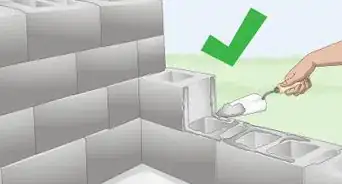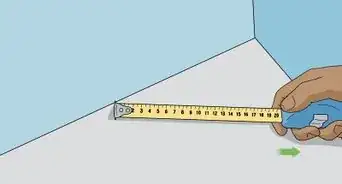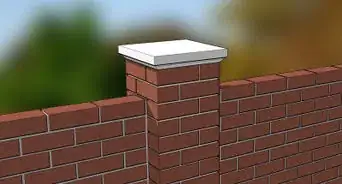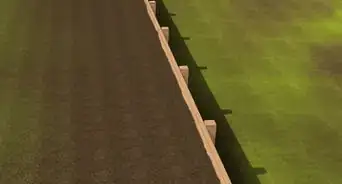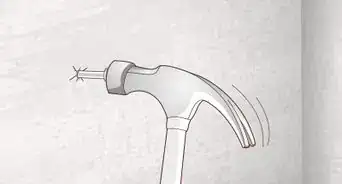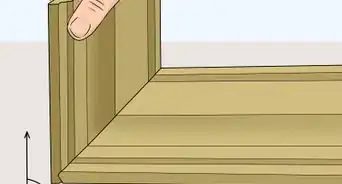This article was co-authored by Agustin Renoj. Agustin Renoj is a Home Improvement Specialist with Renoj Handyman based in the San Francisco Bay Area. With over 18 years of construction experience, Agustin specializes in carpentry, painting, and exterior, interior, kitchen, and bathroom renovations. Renoj Handyman is a family-owned business that consists of craftsmen trained in all areas of construction.
This article has been viewed 312,887 times.
Scaffolding is often a necessary part of building and home maintenance. Set up scaffolding properly to make sure you and anyone else using the equipment stay safe. An oversight in erecting scaffolding could lead to a serious accident. Setting up scaffolding is an alternative to using ladders. A benefit of using scaffolding is the larger work area and mobility it offers over that of a ladder. It provides a platform for walking and for setting all your tools. This cuts work time drastically.
Steps
-
1Select a secure foundation on which to build and set your scaffold. Obtain mud sills or base plates to attach the scaffolding to make the footing more stable. One of the main concerns here is to have the scaffolding level and on secure ground. If you are on unlevel ground, you my need to dig down to make the dirt level in any high corner. Also, use the adjusting screws on the scaffolding to level the structure. If the surface is on a drastic slope, obtain leg extensions.[1]
-
2Opt for casters. If you plan on moving your scaffolding to work on various spots, include casters in your scaffolding setup. Remember to lock the casters when you get it into place.Advertisement
-
3Assemble the scaffolding frame.[2] Lay out the ends of the scaffolding. Lift one end piece, and attach the upper cross brace. The far end of this brace should support the end piece while you lift the second end piece and attach its upper cross brace. Secure the ends of the cross braces to the bottom of the opposite end frame.
-
4Make sure the scaffold is stable. Move the scaffold into your desired position, and make sure it is level and secure.
-
5Place the planks.[3] Lift the planks through the scaffold bars and into place. Hardware should be included to fasten the planks into place.
-
6Secure access to the scaffold. If ladders are used to access the scaffold, use ones that are designed for that specific scaffold. Stair-like ladders can be used to access the scaffold but must have handrails and treading. A concern with the access point is to make it safe to maneuver and to prevent the scaffold from tipping over.
-
7
-
8Inspect the scaffolding to ensure safety. Thoroughly examine the scaffolding setup to make sure all pieces are secure. Reinspect the scaffold system every time you leave the site and return to it to make sure it is still safe.
-
9Finished.
Expert Q&A
Did you know you can get premium answers for this article?
Unlock premium answers by supporting wikiHow
-
QuestionWhy do you need guardrails on scaffolding?
 Agustin RenojAgustin Renoj is a Home Improvement Specialist with Renoj Handyman based in the San Francisco Bay Area. With over 18 years of construction experience, Agustin specializes in carpentry, painting, and exterior, interior, kitchen, and bathroom renovations. Renoj Handyman is a family-owned business that consists of craftsmen trained in all areas of construction.
Agustin RenojAgustin Renoj is a Home Improvement Specialist with Renoj Handyman based in the San Francisco Bay Area. With over 18 years of construction experience, Agustin specializes in carpentry, painting, and exterior, interior, kitchen, and bathroom renovations. Renoj Handyman is a family-owned business that consists of craftsmen trained in all areas of construction.
Home Improvement Specialist
-
QuestionDo you need to be qualified to erect scaffolding?
 wikiHow Staff EditorThis answer was written by one of our trained team of researchers who validated it for accuracy and comprehensiveness.
wikiHow Staff EditorThis answer was written by one of our trained team of researchers who validated it for accuracy and comprehensiveness.
Staff Answer wikiHow Staff EditorStaff AnswerIn the U.S., OSHA regulations require that scaffolding on a construction site be erected and inspected by a “competent person” who has training and experience with using scaffolding properly. Your employer may provide training and periodic refresher courses to make sure you are aware of all the potential hazards and safety requirements.
wikiHow Staff EditorStaff AnswerIn the U.S., OSHA regulations require that scaffolding on a construction site be erected and inspected by a “competent person” who has training and experience with using scaffolding properly. Your employer may provide training and periodic refresher courses to make sure you are aware of all the potential hazards and safety requirements. -
QuestionCan a neighbor erect scaffolding on my property?
 wikiHow Staff EditorThis answer was written by one of our trained team of researchers who validated it for accuracy and comprehensiveness.
wikiHow Staff EditorThis answer was written by one of our trained team of researchers who validated it for accuracy and comprehensiveness.
Staff Answer wikiHow Staff EditorStaff Answer
wikiHow Staff EditorStaff Answer
Things You'll Need
- mud sills or base plates
- scaffold parts
- ladder or stairs
References
- ↑ https://www.osha.gov/laws-regs/standardinterpretations/2000-08-01-1
- ↑ https://www.familyhandyman.com/tools/how-to-work-with-scaffolding-safely/
- ↑ https://www.familyhandyman.com/tools/how-to-work-with-scaffolding-safely/
- ↑ https://www.familyhandyman.com/tools/how-to-work-with-scaffolding-safely/
- ↑ Agustin Renoj. Home Improvement Specialist. Expert Interview. 13 January 2021.
- ↑ https://www.ehss.vt.edu/programs/SCA_proper_erection.php
- https://www.haringey.gov.uk/parking-roads-and-travel/roads-and-streets/building-near-road/scaffold-hoarding-container-and-crane-licences/guide-safe-erection-and-dismantling-scaffolding
- https://www.safeworkaustralia.gov.au/system/files/documents/1703/scaffolds-scaffolding-work-general-guide.pdf



